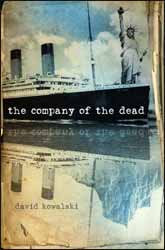|
Click here to return to the main site. Book Review
The world stands on the brink of war. The empires of Germany and Japan can no longer continence the others existence, but in a world of atomic weapons another war may well spell the death of all humanity. The only solution appears not to reside in the present, but in the past as the worlds fate turns on a single event, the sinking of the Titanic... The Company of the Dead is the impressively intelligent first novel from Australian author David J. Kowalski. The novel is set in a world where an alternative history has developed from the beginnings of the First World War. In Kowalski’s scenario America failed to join the allies, allowing Germany, under the Kaiser, to triumph. In the East, Japan’s march through Manchuria is relatively unchallenged with the dissolution of the British Empire. Mexico has become a minor empire continually launching military incursions into the Southern Second Confederacy, whilst what’s left of the Northern Union suffers the ignominy of having both its east and west coast occupied by the Japanese. In this radically altered world Lightholler, Captain of the newly commissioned Titanic and a former British Naval officer finds himself embroiled in a plot, instigated by Joseph Robard Kennedy, Assistant Director of the CBI, the intelligence arm of the Second Confederacy. His life is placed in danger as various intelligence factions vie for either his help or his death. Alternate histories have a long tradition, which stretch back as far as Livy. Through the past two centuries the genre was initially used to explore philosophical questions, but following the Second World War the genre became more associated with science fiction with George Orwell’s 1984 (1948) which postulated a world where the war never ended and Philip K. Dick’s The Man in The High Castle (1962) which likewise presented a world where Japan and Germany won the war and now conduct their political games on the decaying bones of a once powerful America. Of course, the mark of a good alternative history is the ability of the author to make his new construct seem possible and Kowalski has spent considerable effort and research to draw the strands of his world together to make a convincingly coherent whole. Kowalski has produced a veritable door stop of a book, running to seven hundred and fifty pages, and not a page is wasted. The text is rich with depth as the author takes the reader through the complex sociopolitical history which developed following the original sinking of the Titanic. Historical characters are used, Patton, the Kennedy’s, even Hitler gets a mention as a minor artist. None of the portrayals are outside the bounds of possibility, nor are any of the changes, in themselves, momentous, but their cumulative effect is to create a radically different world, which at the same time feels oddly familiar. The story opens with Jonathon Wells, a well-meaning time traveller who, with the aid of a pair of modern binoculars, intends to stop the sinking of the Titanic. A laudable, if odd ambition, most modern time traveller’s usually wrestle with the moral conundrum of killing Hitler as a child. His attempt to save the passengers is the focus event which creates a new, not so brave, world. Kennedy becomes aware of the alteration and attempts to thwart the change, even though it would create a world where all the horrors of the Second World War occurred. Better to have humanity, with all its faults and atrocities, have a chance at survival, than create the conditions where a final atomic holocaust ends all life. What follows is a well-constructed and intricate burlesque of a plot where Kowalski unpeels each layer of the story slowly enough to keep you interested without giving the whole game away. He shows a real touch with his characterisations and dialogue, which is often missing from more seasoned authors, each have their own backstory and individual voice, allowing the reader to empathise and thereby get drawn into the overall story. The end of humanity and time travel should not put off the casual reader. Although, it is a book which requires the audience to take the narrative seriously, there is never-the-less a good swath of action sequences - The fall of New York and Berlin, flights from death and danger - as well as a proto love story to keep things moving along at a pace. It’s almost a perfect convergence of art and action. The pace is aided by having the book cut into lots of small chapters which keeps the action shifting. Under all the surface plot devices, what we have here is a splendidly written thriller, in much the same way as Audrey Niffenegger’s The Time Traveller's Wife (2003) was ultimately a masterful love story, which used time travel to enhance its narrative. So don’t be put off by any of the surface structure which helps to support the story. Labyrinthine in its construction and detail, The Company of the Dead is also a great read. Given its premise and construction it should appeal to a wide audience. 10 Charles Packer |
|---|


